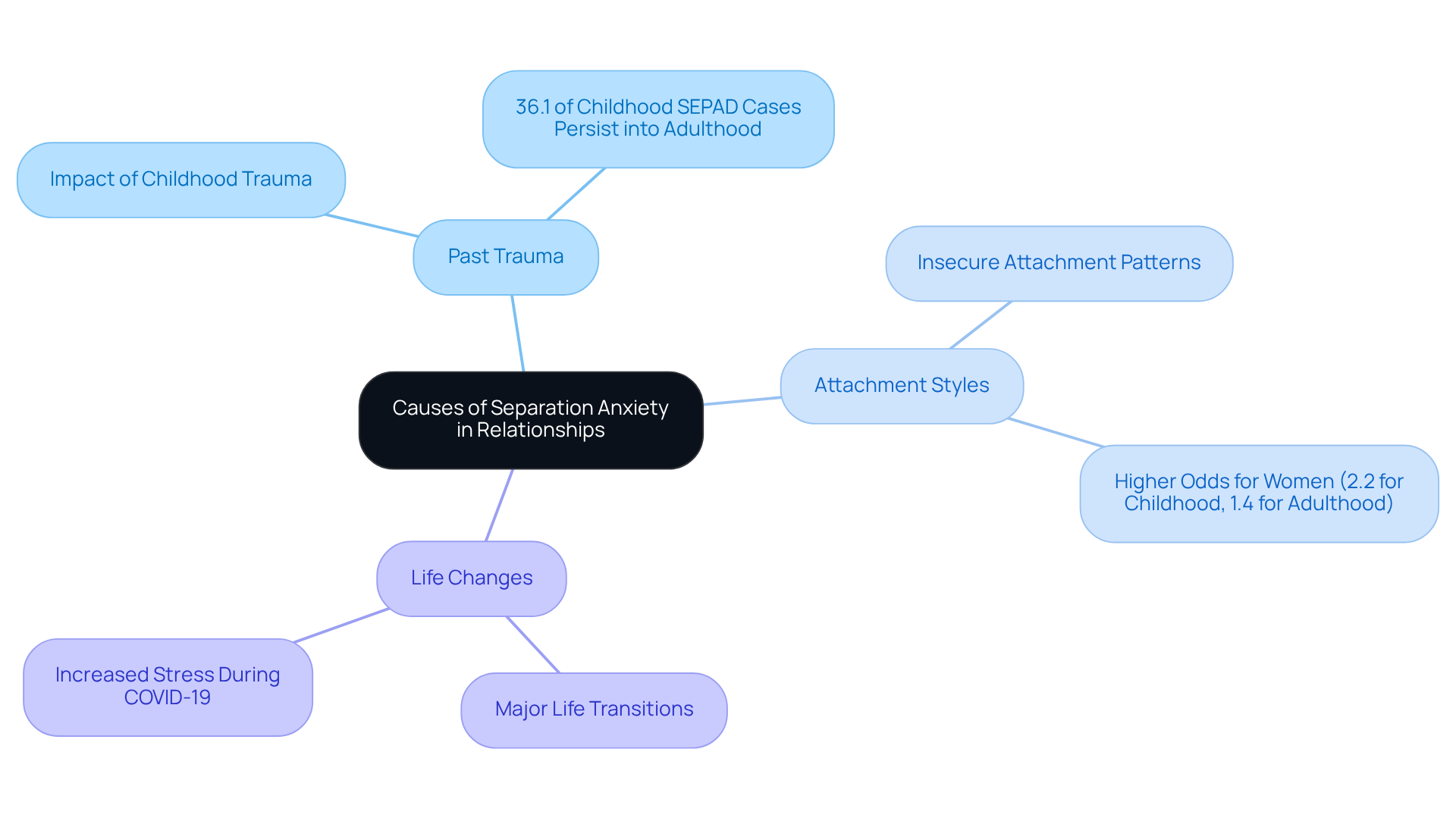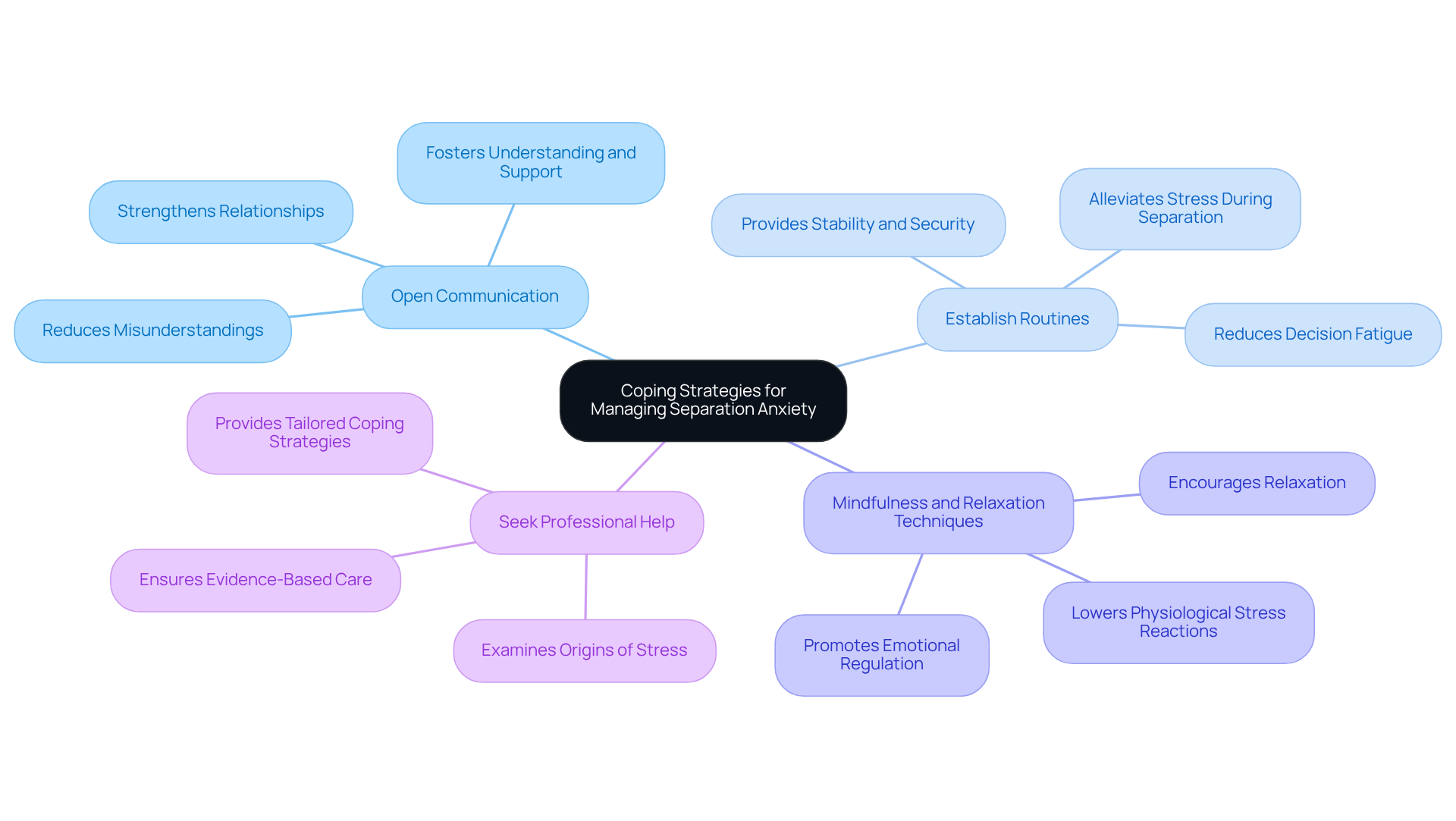Overview
Separation anxiety in relationships can evoke intense fear and discomfort when apart from a partner. This emotional turmoil often leads to excessive worry, dependency, and strain on the relationship. Understanding these feelings is the first step toward healing. Have you ever felt overwhelmed by the thought of being away from someone you care about? It’s important to recognize that you are not alone in this experience.
This article outlines the symptoms, causes, and coping strategies for managing separation anxiety. Symptoms may include persistent worry about your partner's well-being or an overwhelming sense of dread when anticipating time apart. Recognizing these signs can be empowering, as it opens the door to understanding and addressing your feelings.
The causes of separation anxiety can vary, often rooted in past experiences or attachment styles. By exploring these underlying issues, you can begin to foster healthier relationship dynamics. Communication plays a crucial role in this process. Expressing your feelings to your partner can strengthen your bond and create a supportive environment.
In addition to communication, establishing routines can help ease the discomfort of separation. Creating rituals or schedules can provide a sense of stability and predictability, making time apart feel less daunting. Seeking professional support is also a vital step in this journey. A therapist can offer guidance and strategies tailored to your unique situation, helping you navigate these emotions with compassion.
As we explore these strategies further, remember that healing is a journey. It’s okay to seek help and take steps toward a more balanced relationship. By prioritizing your emotional well-being, you can cultivate a deeper connection with your partner and foster resilience in your relationship. Together, let’s take the first steps toward understanding and healing.
Introduction
Separation anxiety can cast a long shadow over romantic relationships, often leading to emotional distress and communication breakdowns. Have you ever felt overwhelmed by the fear of losing someone you love? As individuals grapple with intense fears of abandonment and the overwhelming need for reassurance, the impact can strain even the strongest of bonds.
This article delves into the symptoms and underlying causes of separation anxiety, offering insights into how partners can recognize these challenges and implement effective coping strategies. As we explore this further, how can couples navigate the complexities of separation anxiety to foster healthier, more resilient connections?
Define Separation Anxiety and Its Impact on Relationships
Separation distress is a deeply felt experience, marked by intense fear or discomfort when we are parted from a loved one or attachment figure. In romantic relationships, separation anxiety in relationships can manifest as excessive worry for a partner's safety, a fear of rejection, and a strong desire for constant closeness. The effects on relationships can be significant, often resulting in communication breakdowns, increased dependency, emotional strain, and separation anxiety in relationships. Partners may find themselves feeling overwhelmed by the anxious individual's need for reassurance, which can create tension and conflict.
Have you ever felt overwhelmed by your past? Recent studies indicate that approximately 6.6% of the adult U.S. population suffers from emotional distress disorder (SAD), with around 77.5% of adults experiencing their first onset during adulthood, typically around age 23. Understanding this dynamic is essential for both partners as they navigate their feelings and work toward healthier interactions. By recognizing the signs and impacts of distress from separation anxiety in relationships, partners can collaborate to develop coping strategies that enhance emotional resilience and strengthen their bond.
The Emerald Couch is dedicated to providing customized psychotherapy services for adults dealing with trauma and stress-related disorders, including separation anxiety in relationships. Their approach often incorporates Cognitive Processing Therapy (CPT), a structured method designed to help individuals process traumatic experiences and cultivate healthier coping strategies.
It's also important to recognize that SAD has a heritability estimate of 73%, indicating a potential genetic component to the disorder. Furthermore, individuals with SAD may encounter comorbidities such as PTSD, panic disorder, and generalized anxiety, complicating interpersonal dynamics.
As we explore these challenges together, remember that seeking support can be a vital step toward healing and connection.

Identify Symptoms of Separation Anxiety: Physical, Behavioral, and Cognitive
The symptoms of distress related to parting can manifest in physical, behavioral, and cognitive areas, with separation anxiety in relationships significantly impacting adult relationships.
Physical Symptoms: Have you ever felt a tightness in your chest or a knot in your stomach at the thought of separation? Individuals may experience headaches, stomachaches, nausea, and even panic attacks when anticipating a parting. These physical symptoms often extend to sleep disturbances and fatigue, common among those grappling with stress. Research indicates that untreated emotional disorders can diminish one’s quality of life, underscoring the importance of addressing these symptoms promptly.
Behavioral Symptoms: You might notice yourself becoming excessively clingy or feeling the urge to check in frequently on your partner. This reluctance to engage in activities that require separation can stem from separation anxiety in relationships, which is a deep-seated fear of losing someone you care about. Such behaviors can create separation anxiety in relationships, as partners may feel overwhelmed or pressured. Understanding these patterns is crucial for nurturing healthier connections.
Cognitive Symptoms: Intrusive thoughts about potential dangers to your partner can creep in, leading to catastrophic thinking about your relationship. This cycle of worry can exacerbate stress and emotional distress. Studies show that emotional distress related to separation anxiety in relationships can affect adults similarly to how it is observed in children, highlighting the need for thorough treatment methods that address these complex emotional challenges.
Recognizing these symptoms is essential for fostering healthier interpersonal dynamics and encouraging personal growth. By identifying the indicators of distress related to parting, individuals can seek appropriate support and interventions, paving the way for improved mental well-being and fulfillment in their relationships. Remember, reaching out for help is a brave and important step towards healing.
Explore Causes of Separation Anxiety in Relationships
Separation anxiety can arise from a variety of factors, including:
- Past Trauma: Have you ever felt overwhelmed by your past? Individuals with a history of trauma, particularly those related to loss or abandonment, often find themselves more vulnerable to separation anxiety. Such experiences can instill profound fears that resurface in adult relationships, contributing to separation anxiety in relationships and leading to heightened emotional distress. Research indicates that approximately 36.1% of individuals with childhood Separation Anxiety Disorder (SEPAD) continue to experience symptoms into adulthood, highlighting the long-lasting effects of early trauma.
- Attachment Styles: Insecure attachment patterns, usually developed during childhood, can greatly lead to distress during parting. Those with anxious attachment may display separation anxiety in relationships, which can manifest as increased fears of abandonment and a persistent need for reassurance from partners. Research indicates that women are more likely to encounter SEPAD, with odds ratios of 2.2 for childhood and 1.4 for adulthood, implying that attachment dynamics significantly influence the occurrence of psychological disorders.
- Life Changes: Major life transitions—such as relocating, changing jobs, or navigating significant relationship shifts—can trigger feelings of distress. These changes frequently provoke sensations of instability and the fear of losing emotional ties, leading to increased separation anxiety in relationships. For example, during the COVID-19 pandemic, numerous people reported heightened stress levels, especially among those with pre-existing vulnerabilities.
Comprehending these fundamental reasons is essential for those aiming to tackle their stress and develop healthier relationship patterns. By understanding the interaction among previous trauma, attachment patterns, and life transitions, individuals can more effectively manage their emotional experiences and strive for healing. Remember, seeking support is a brave step toward nurturing your emotional well-being.

Coping Strategies for Managing Separation Anxiety
To manage separation anxiety effectively, individuals can adopt several compassionate coping strategies:
- Open Communication: Have you ever felt overwhelmed by your anxiety? Discussing these feelings with a partner can foster understanding and support. Open dialogue allows both partners to navigate their emotions together, establishing reassurance mechanisms that are crucial for emotional stability. Therapists emphasize that clear communication can significantly reduce misunderstandings and strengthen relationships, creating a nurturing environment for healing.
- Establish Routines: Consider how predictable routines can provide a sense of stability and security. Creating regular check-ins or designated times to connect can alleviate stress during times of separation. Research suggests that individuals who uphold organized routines experience reduced stress levels, as routines substitute unpredictability with familiarity, offering comfort and reassurance.
- Mindfulness and Relaxation Techniques: Have you taken a moment to breathe deeply today? Practicing mindfulness, meditation, or deep-breathing exercises can help manage stress symptoms. These techniques encourage relaxation and lessen the physiological reactions linked with stress, aiding in better emotional regulation. Research indicates that integrating mindfulness techniques can reduce stress symptoms by as much as 30%, promoting a sense of calm and well-being.
- Seek Professional Help: Engaging with a therapist who specializes in trauma-informed care can provide valuable support on your journey. Therapy allows individuals to examine the origins of their stress and create tailored coping strategies. The commitment to high-quality, evidence-based care ensures that clients receive the necessary tools for effective healing, guiding them towards a brighter future.
Implementing these strategies can significantly improve emotional well-being and enhance relationship dynamics. By taking these steps, you can navigate your anxiety with greater resilience, fostering a deeper connection with yourself and those around you.

Conclusion
Separation anxiety in relationships is a complex emotional experience that can deeply impact the dynamics between partners. It often manifests as an intense fear of being apart, excessive worry, and a strong desire for closeness. These feelings can lead to communication breakdowns and increased dependency, making it crucial to recognize and address these issues for healthier interactions and emotional resilience within romantic partnerships.
As we explore this further, key insights into the symptoms, causes, and coping strategies associated with separation anxiety come to light. Physical symptoms like panic attacks, behavioral signs such as clinginess, and cognitive challenges including intrusive thoughts all contribute to the emotional distress individuals may experience. Additionally, the roots of separation anxiety often lie in past trauma, attachment styles, and life changes. Understanding these factors is essential for effective management and healing.
Ultimately, addressing separation anxiety goes beyond alleviating personal distress; it’s about nurturing deeper connections and fostering emotional well-being in relationships. By implementing strategies like open communication, establishing routines, and seeking professional help, individuals can create a supportive environment that encourages healing and growth. Have you ever felt overwhelmed by your past? Embracing these steps can lead to a more fulfilling and resilient partnership, underscoring the importance of understanding and managing separation anxiety in relationships.
Frequently Asked Questions
What is separation anxiety in the context of relationships?
Separation anxiety in relationships is a deeply felt experience characterized by intense fear or discomfort when apart from a loved one or attachment figure, often leading to excessive worry for a partner's safety and a fear of rejection.
How does separation anxiety affect romantic relationships?
It can lead to significant effects such as communication breakdowns, increased dependency, emotional strain, and tension between partners, as one partner may feel overwhelmed by the anxious individual's need for reassurance.
What is the prevalence of separation anxiety disorder (SAD) among adults?
Approximately 6.6% of the adult U.S. population suffers from emotional distress disorder (SAD), with around 77.5% experiencing their first onset during adulthood, typically around age 23.
What can partners do to manage separation anxiety in their relationship?
Partners can recognize the signs and impacts of separation anxiety, collaborate to develop coping strategies, and enhance emotional resilience to strengthen their bond.
What therapeutic approach does The Emerald Couch use for separation anxiety?
The Emerald Couch offers customized psychotherapy services, often incorporating Cognitive Processing Therapy (CPT), which helps individuals process traumatic experiences and develop healthier coping strategies.
Is there a genetic component to separation anxiety disorder?
Yes, SAD has a heritability estimate of 73%, suggesting a potential genetic component to the disorder.
What comorbidities are associated with separation anxiety disorder?
Individuals with SAD may also experience comorbidities such as PTSD, panic disorder, and generalized anxiety, which can complicate interpersonal dynamics.




